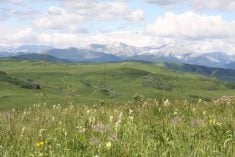Protein premiums help hard red spring wheat producers to make a profit.
But for many growers, those last few protein points may cost more than they’re worth.
Those considering the market and its protein premiums will have to spend money to make money, agronomists say. Even then it’s a gamble, and farmers should consider their past protein levels before deciding to grow Canadian Western Spring Wheat this season.
Brian Fowler, a research scientist with the Crop Development Centre at the University of Saskatchewan, says protein is a management issue that producers can measure for themselves at harvest time.
Read Also

Gene editing digs deeper space in Canadian plant breeding
More Canadian research into crop variety development is incorporating gene editing, and one researcher notes that Canada’s regulatory approach to gene editing will help drive innovation
“If a farmer finds himself consistently growing (CWRS) wheat that has less than 13.5 percent protein, then he has left money in the field by not providing enough available nitrogen,” said Fowler.
Those who ensure there is sufficient nitrogen to maximize yield have a better chance of attaining premiums for protein.
Plant breeders agree.
“In terms of economic returns to the producer, the producer must capture all of the resource that is available for the crop, using all of the moisture and all of the nitrogen that is out there,” said Ron DePauw, a cereal plant breeder with Agriculture Canada in Swift Current, Sask.
“Fertilizing to soil test recommendations is a necessity for hard red spring wheats.”
But how much additional nitrogen is needed to gain additional protein? And is it worth the extra cost?
“If a farmer decides to foliar spray 15 pounds of nitrogen in June, that will cost about $3.75 an acre just for the nitrogen,” said Fowler.
“He might double that price for labor and application costs. If the protein premium is 10 cents a bushel and he grows a 35-bushel crop, the result is lost money. That is an easy decision.”
Tests done at Agriculture Canada’s Swift Current research centre show nitrogen applications later in the growing season do increase protein levels, and further research could determine the best timing.
Chlorophyll meters can be used to measure plant nitrogen content, as they are in corn, but meters cost $2,000 each so it isn’t practical for most farmers. Nor is meter reliability fully proven by scientists.
As yield increases, so does the amount of nitrogen needed to increase protein. Higher moisture levels increase the starch produced by plants so protein concentration is diluted. To maintain high protein, even more nitrogen is required.
“At a certain point, somewhere around 13 or 13.5 percent protein, the plant will maximize its yield. Protein above that point becomes expensive to achieve,” said DePauw.
Weather is the key
Weather is the wild card, as always. If there is too much rain, fertilizing will bring higher yields but lower protein. Too little rain, and growers will likely have spent more on fertilizer than they will realize in protein premiums.
“It’s a bit of crap shoot,” said Adrian Johnston of Agriculture Canada in Melfort, Sask. He figures protein may be most profitably attained in semi-arid growing areas on summerfallow fields.
“On summerfallow, with proper fertilization and reasonable amounts of moisture, the plant has its best chance of obtaining the necessary nitrogen and growing conditions.
Growers in darker soil zones, where moisture is more abundant, are probably better off aiming for high yield in CPS varieties when prices for high protein wheats are low, said Johnston.
Wheat planted into pea stubble has a better chance of earning a protein premium because the stubble provides extra nitrogen later in the growing season, when the crop can best convert it to protein.
Johnston said continuous cropping trends seem to have generally lowered wheat protein concentrations. Background levels of soil nitrogen have fallen to record lows and producers must provide nearly all the required crop nutrients.
Nitrogen is critical to CWRS varieties, so cutting costs on that fertilizer is not a common option.
Researchers are concerned that zero and minimum tillage producers seldom see high protein levels in their crops.
They speculate that higher moisture content in the top layer of low-tillage soils may prompt greater microbial action. This may be responsible for conversion of soil nitrates to nitrous oxide, which is lost to the atmosphere and unavailable to the plant.














